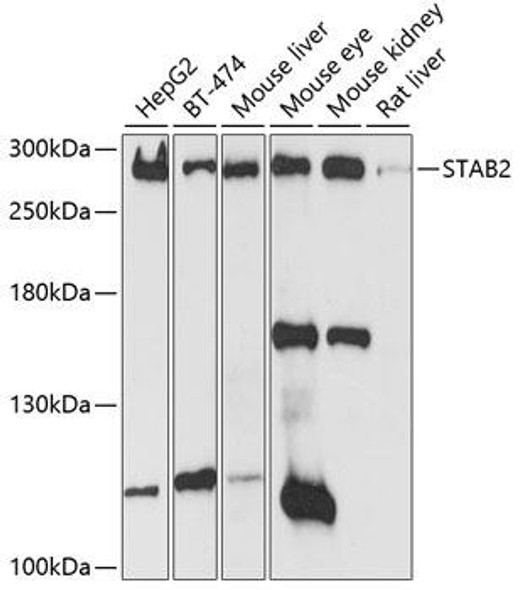Anti-CLSTN1 Antibody (CAB15405)
- SKU:
- CAB15405
- Product type:
- Antibody
- Reactivity:
- Mouse
- Rat
- Host Species:
- Rabbit
- Isotype:
- IgG
- Antibody Type:
- Polyclonal Antibody
- Research Area:
- Cell Biology
Frequently bought together:
Description
| Antibody Name: | Anti-CLSTN1 Antibody |
| Antibody SKU: | CAB15405 |
| Antibody Size: | 20uL, 50uL, 100uL |
| Application: | WB IF |
| Reactivity: | Mouse, Rat |
| Host Species: | Rabbit |
| Immunogen: | Recombinant fusion protein containing a sequence corresponding to amino acids 29-350 of human CLSTN1 (NP_055759.3). |
| Application: | WB IF |
| Recommended Dilution: | WB 1:200 - 1:2000 IF 1:50 - 1:200 |
| Reactivity: | Mouse, Rat |
| Positive Samples: | Mouse brain, Rat brain |
| Immunogen: | Recombinant fusion protein containing a sequence corresponding to amino acids 29-350 of human CLSTN1 (NP_055759.3). |
| Purification Method: | Affinity purification |
| Storage Buffer: | Store at -20°C. Avoid freeze / thaw cycles. Buffer: PBS with 0.02% sodium azide, 50% glycerol, pH7.3. |
| Isotype: | IgG |
| Sequence: | ARVN KHKP WLEP TYHG IVTE NDNT VLLD PPLI ALDK DAPL RFAG EICG FKIH GQNV PFDA VVVD KSTG EGVI RSKE KLDC ELQK DYSF TIQA YDCG KGPD GTNV KKSH KATV HIQV NDVN EYAP VFKE KSYK ATVI EGKQ YDSI LRVE AVDA DCSP QFSQ ICSY EIIT PDVP FTVD KDGY IKNT EKLN YGKE HQYK LTVT AYDC GKKR ATED VLVK ISIK PTCT PGWQ GWNN RIEY EPGT GALA VFPN IHLE TCDE PVAS VQAT VELE TSHI GKGC DRDT YSEK SLHR LCGA AAGT AELL PSPS GSLN WTMG LPTD NGHD SD |
| Gene ID: | 22883 |
| Uniprot: | O94985 |
| Cellular Location: | Cell junction, Cell projection, Endoplasmic reticulum membrane, Golgi apparatus membrane, Nucleus, Single-pass type I membrane protein, postsynaptic cell membrane, synapse |
| Calculated MW: | 108kDa/109kDa |
| Observed MW: | 110kDa |
| Synonyms: | CLSTN1, ALC-ALPHA, CDHR12, CST-1, CSTN1, PIK3CD, XB31alpha, alcalpha1, alcalpha2 |
| Background: | This gene is a member of the calsyntenin family, a subset of the cadherin superfamily. The encoded transmembrane protein, also known as alcadein-alpha, is thought to bind to kinesin-1 motors to mediate the axonal anterograde transport of certain types of vesicle. Amyloid precursor protein (APP) is trafficked via these vesicles and so this protein is being investigated to see how it might contribute to the mechanisms underlying Alzheimer's disease. Alternative splicing results in multiple transcript variants. |
| UniProt Protein Function: | CLSTN1: Induces KLC1 association with vesicles and functions as a cargo in axonal anterograde transport. Complex formation with APBA2 and APP, stabilizes APP metabolism and enhances APBA2- mediated suppression of beta-APP40 secretion, due to the retardation of intracellular APP maturation. In complex with APBA2 and C99, a C-terminal APP fragment, abolishes C99 interaction with PSEN1 and thus APP C99 cleavage by gamma-secretase, most probably through stabilization of the direct interaction between APBA2 and APP. The intracellular fragment AlcICD suppresses APBB1-dependent transactivation stimulated by APP C-terminal intracellular fragment (AICD), most probably by competing with AICD for APBB1- binding. May modulate calcium-mediated postsynaptic signals. 2 isoforms of the human protein are produced by alternative splicing. |
| UniProt Protein Details: | Protein type:Membrane protein, integral; Cell surface Chromosomal Location of Human Ortholog: 1p36.22 Cellular Component: Golgi membrane; postsynaptic membrane; endoplasmic reticulum membrane; cell projection; integral to membrane; cell junction; nucleus Molecular Function:protein binding; X11-like protein binding; kinesin binding; beta-amyloid binding; calcium ion binding Biological Process: homophilic cell adhesion; cell adhesion |
| NCBI Summary: | This gene is a member of the calsyntenin family, a subset of the cadherin superfamily. The encoded transmembrane protein, also known as alcadein-alpha, is thought to bind to kinesin-1 motors to mediate the axonal anterograde transport of certain types of vesicle. Amyloid precursor protein (APP) is trafficked via these vesicles and so this protein is being investigated to see how it might contribute to the mechanisms underlying Alzheimer's disease. Alternative splicing results in multiple transcript variants. [provided by RefSeq, Nov 2014] |
| UniProt Code: | O94985 |
| NCBI GenInfo Identifier: | 23396490 |
| NCBI Gene ID: | 22883 |
| NCBI Accession: | O94985.1 |
| UniProt Secondary Accession: | O94985,Q5SR52, Q5UE58, Q71MN0, Q8N4K9, A8K183, |
| UniProt Related Accession: | O94985 |
| Molecular Weight: | 108,643 Da |
| NCBI Full Name: | Calsyntenin-1 |
| NCBI Synonym Full Names: | calsyntenin 1 |
| NCBI Official Symbol: | CLSTN1 |
| NCBI Official Synonym Symbols: | CST-1; CSTN1; CDHR12; PIK3CD; ALC-ALPHA; XB31alpha; alcalpha1; alcalpha2 |
| NCBI Protein Information: | calsyntenin-1; alcadein-alpha; alzheimer-related cadherin-like protein; cadherin-related family member 12; non-classical cadherin XB31alpha |
| UniProt Protein Name: | Calsyntenin-1 |
| UniProt Synonym Protein Names: | Alcadein-alpha; Alc-alpha; Alzheimer-related cadherin-like protein; Non-classical cadherin XB31alphaCleaved into the following 2 chains:Soluble Alc-alpha; SAlc-alpha; CTF1-alphaAlternative name(s):C-terminal fragment 1-alpha |
| Protein Family: | Calsyntenin |
| UniProt Gene Name: | CLSTN1 |
| UniProt Entry Name: | CSTN1_HUMAN |









